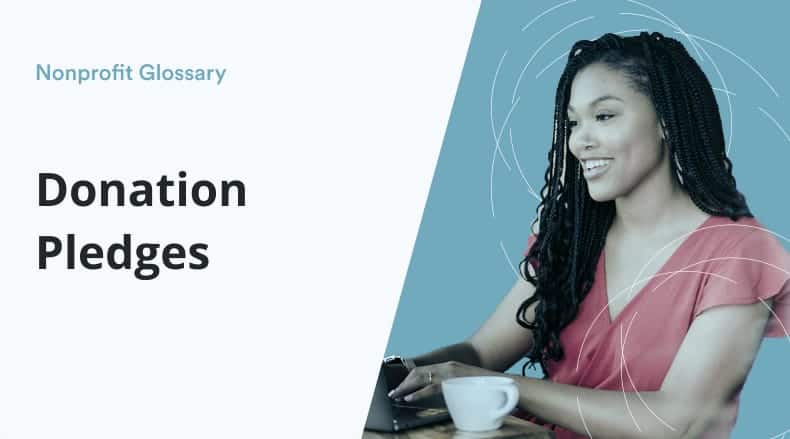Donation Pledges

What are donation pledges?
Donation pledges are donors’ promises to give a certain amount of money to an organization over a set amount of time. Donors can make pledges that are conditional, meaning payment will only be made once a condition is met, or unconditional, meaning there are no strings attached.
Nonprofits typically use donation pledges for campaigns built around specific and often urgent projects. These projects could include disaster relief, advocacy work around a specific social or political issue, major programs, or community projects.
What’s the difference between pledges and donations?
It can be easy to confuse a donation and a pledge because they are closely related. Both a pledge and a donation result in donors giving money or goods to a nonprofit. But the big difference between a donation and a pledge is the timing.
A donation describes the immediate exchange of money or goods from a donor. A pledge is the promised exchange of money or goods from a donor. A pledge results in a donation eventually, just not right away.
How do you get donors to make pledges?
Supporters make donation pledges when they feel deeply connected to the project and the organization’s work. Get donors to make donation pledges by tapping into their emotional connections with your organization and the community. Organizations can do this by communicating their need for support in a powerful way.
For example, you might gather photos, videos, and audio clips of your organization’s beneficiaries talking about what donors’ support means to them. You can incorporate these multimedia elements into email campaigns, social media posts, direct mail outreach, and other marketing communications.
Donors will be able to get to know the people your organization supports, building an emotional connection to your cause.
How do you receive donation pledges?
There are several ways to get your supporters to make a pledge. Here are four popular methods:
Pledge Cards
Donors fill out pledge cards to show their commitment to supporting an organization. Pledge cards ask donors to give information like their names, addresses, and phone numbers, as well as pledge amounts. They also offer any additional information the donor might need, such as payment methods accepted by the organization.
Donation Pledge Form
Like pledge cards, pledge forms are filled out by donors with information about their intended pledge. However, forms include a space for payment information so that donors can begin giving immediately.
Text-To-Pledge
Like text-to-give, text-to-pledge allows supporters to use their mobile devices to make monetary pledges to organizations. Many prefer a technological method like this because it eliminates manual data entry. See what options your donor management system has to collect pledges virtually to help automate the process.
Donation Page
Some online fundraising tools allow you to collect pledges right from your donation page in addition to immediate donations. The benefit of this option, like text-to-pledge, is that the information automatically syncs with your fundraising and donor management software, eliminating the need to enter information manually.
How do you receive payment for donation pledges?
Most donors pledge to give a sum of money slowly over a few years. Donors can pay their pledge by check, credit card, or automatic withdrawal.
Check your fundraising and donor database software to see how they integrate pledges into the system. For example, when you use Bloomerang + Kindful’s pledge functionality, you can set the due date for the pledge and track the status as open, past due, completed, or canceled. You can then collect your donor’s payment through your integrated payment processor or mark it as paid by check or cash.
In addition, Bloomerang’s pledge features allow you to:
- Set customized installment schedules for each donor based on their intentions.
- Easily gain a high-level overview of where your pledge progress stands using an automatically-updated dashboard.
- Adjust pledges as needed to tweak the amount, frequency, payment method, and so on.
Open, honest communication with donors is key to receiving more completed pledges. Focus your donor stewardship efforts on letting supporters know the impact of their donations and how your organization uses them to power your mission.
When supporters see that their gifts can significantly impact your organization’s efforts, they’ll be much more motivated to fulfill their pledges.
Use a pledge reminder letter to remind your donors to give
Pledge reminder letters help keep donors on track with their pledge payments by letting them know a few weeks before a payment is due. Pledge reminder letters should first and foremost express gratitude to the donor for their commitment to your organization. It is also helpful to include the following:
- The date the donor made their pledge
- The pledge amount
- When the next payment is due
- The date the next payment is scheduled
You can automate your pledge reminder letters using the mail merge feature on most donor management systems.
The bottom line
Pledges are a great way to secure consistent support over a prolonged period of time. Donors make pledges to show their deep connection to and support for an organization.
Related Resources:
- Creating A Powerful Pledge Campaign: 5 Essential Tips. Snowball’s guide to creating pledge campaigns will help you develop a clear pledge strategy to earn more completed donations.
- Tracking Pledges with Ease in Bloomerang (Feature Spotlight). Find out more about how you can easily track pledges using Bloomerang’s pledge-tracking features.
- 12 of the Best Online Fundraising Platforms for Nonprofits. Pledges are a vital part of your organization’s fundraising efforts. Use this guide to explore top online fundraising platforms to support your pledge efforts and other fundraising campaigns.
